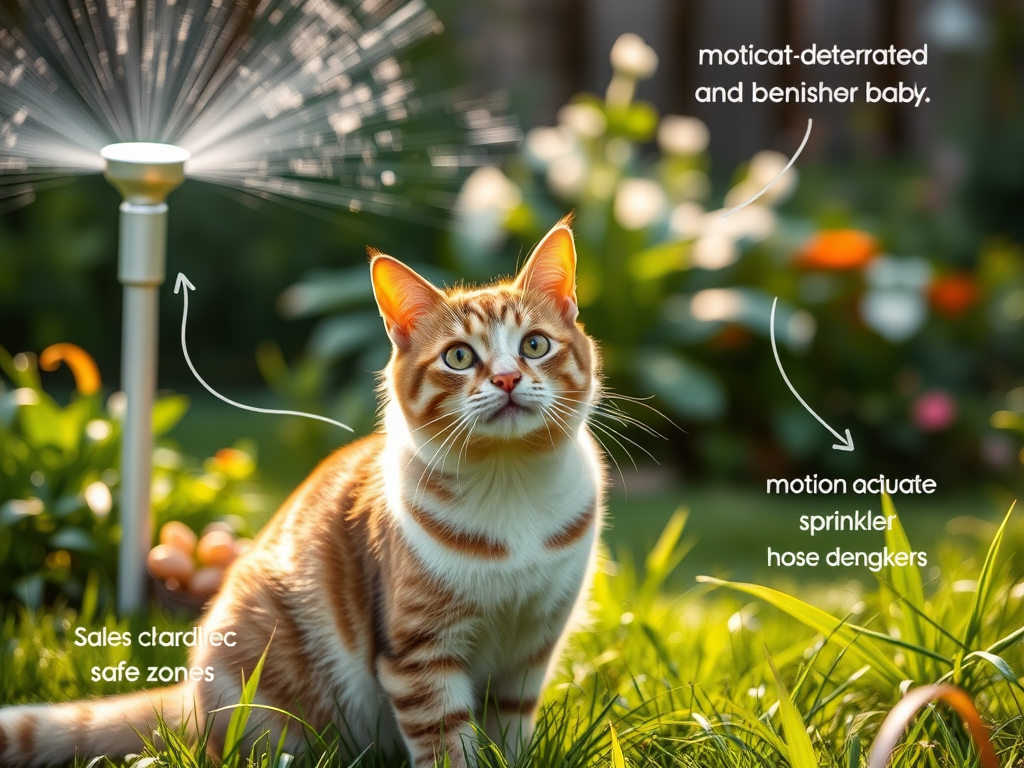Transform Your Home: Effective Strategies to Manage Your Cat’s Hunting Instincts
Mitigating Your Cat’s Impact on Local Wildlife: Cats are inherently skilled hunters, a characteristic that is deeply rooted in their evolutionary history. Although this instinct is essential for their survival in the wild, it can create significant challenges for local wildlife populations when cats roam outdoors unrestricted. To foster a safer coexistence, consider developing a vibrant indoor environment that caters to your cat’s natural hunting desires while safeguarding the delicate balance of outdoor ecosystems. By implementing a variety of engaging activities and sensory-rich spaces, you can keep your cat mentally stimulated and physically active, ensuring their well-being while simultaneously protecting vulnerable wildlife from harm.
Integrating interactive toys into your cat’s playtime can greatly enhance their indoor hunting experience. Opt for toys like feather wands, laser pointers, and remote-controlled mice, which are specifically designed to engage your cat’s attention for extended periods. These playful gadgets mimic the movement of real prey, allowing your cat to hone their tracking and pouncing abilities—skills that are essential for their mental and physical health. By providing these stimulating activities, you not only keep your cat entertained but also encourage regular exercise, helping them channel their energy positively and constructively, ultimately reducing their desire to hunt outdoors.
To create an exciting and dynamic environment for your feline friend, consider designing obstacle courses filled with various elements such as boxes, tunnels, and climbing shelves. This innovative setup encourages your cat to explore, climb, and engage in playful activities that mirror their natural behaviors in a secure setting. Cats are naturally curious creatures, and providing them with diverse terrains and challenges can replicate the thrill of their wild habitat, transforming your home into a captivating adventure zone where they can fully express their instincts.
Don’t underestimate the advantages of puzzle feeders. These clever devices not only stimulate your cat’s intellect but also simulate the effort they would typically exert while hunting in the wild. By incorporating treat-dispensing puzzles into your cat’s feeding routine, you enable them to engage their problem-solving skills while enjoying a rewarding experience. This approach not only keeps your cat entertained but also fosters healthier eating habits, as they learn to work for their treats, thereby reducing the likelihood of boredom-driven hunting behaviors.
Making playtime a priority in your household is essential for strengthening the bond between you and your cat. Engaging in interactive play not only nurtures your relationship but also alleviates stress and frustration they may experience. Dedicate specific times for play sessions using the same engaging toys that capture their attention during solo play. This mutual interaction enhances their emotional well-being and solidifies the connection you share, transforming playtime into a rewarding experience for both you and your beloved feline companion.
Creating a stimulating indoor environment for your cat is not only achievable but can also yield profound rewards. With a sprinkle of creativity and effort, your living space can evolve into an exciting landscape that caters to their instincts while shielding them from outdoor hazards. By implementing thoughtful strategies, you can ensure your indoor cat is not only content but also mentally and physically fulfilled, significantly reducing their urge to hunt and explore outside.

Discovering Exciting New Adventures for Your Cat with Leash Training
Adopting the practice of leash training can unlock a world of safe and enriching outdoor experiences for your cat. While walks are typically associated with dogs, cats can also enjoy exploring the great outdoors with the right training and a bit of patience. By introducing your feline companion to a comfortable harness and leash, you grant them the opportunity to explore nature while ensuring their safety and preventing them from wandering off into potentially dangerous areas.
Begin your leash training journey by choosing a snug yet comfortable harness that is tailored to your cat’s specific body type. Allow your cat to familiarize themselves with the harness before attempting to put it on. Encourage them to sniff and explore the harness to alleviate any anxiety they might feel. Gradually introducing the harness at their own pace helps create positive associations, making the overall experience enjoyable and less stressful for your pet.
Once your cat is comfortable wearing the harness, attach a lightweight leash and start practicing indoors. This familiar environment will help them adjust to the sensation of the leash while building their confidence. Be patient; some initial resistance is completely normal. Taking things slowly will allow your cat to acclimate to this new and exciting experience without feeling overwhelmed or anxious.
When it’s time for your cat’s first outdoor excursion, choose a calm and secure location, such as your backyard or a quiet park. Ensure the area has minimal traffic and distractions to help your cat feel safe and relaxed. Start with brief outdoor sessions to avoid overwhelming them, gradually increasing the duration as they become more comfortable exploring their new surroundings.
Supervised outdoor time enriches your cat’s life, allowing them to experience the sights, sounds, and smells of nature without posing a risk to local wildlife. Imagine the joy on your cat’s face as they encounter new experiences in a secure environment. This valuable bonding time not only enhances their quality of life but also strengthens your relationship, creating unforgettable moments together.
Stories from fellow cat owners can serve as a source of inspiration and motivation. Many have shared initial doubts about their cats adapting to leash walking, but with consistency and positive reinforcement, they have witnessed remarkable transformations in their pets. Celebrate each small achievement as a step towards broadening your cat’s horizons while maintaining their safety and well-being.
By incorporating leash training into your cat’s lifestyle, you facilitate a harmonious blend of outdoor exploration and wildlife protection. This balanced approach allows your cat to enjoy the wonders of the outside world while fostering a sense of security in their environment.
Enhancing Outdoor Experiences with Catios for Safety and Fun
Outdoor cat enclosures, commonly referred to as catios, provide an excellent solution for adventurous cats who crave outdoor experiences without the inherent risks associated with free roaming. These secure spaces allow your feline friends to bask in the beauty of the outdoors while ensuring their safety and helping to protect local wildlife from potential harm.
When contemplating a catio, you have the option to construct one yourself or purchase a pre-made model that fits your available space and budget. Choices can range from simple balcony enclosures to more elaborate backyard constructions. The foremost consideration when designing a catio should be the security of the structure; ensuring it is escape-proof is essential to provide a safe haven for your cat.
As you plan your catio, consider incorporating multiple levels and cozy hiding spots. Cats thrive in environments that provide vertical spaces and areas to retreat. By including platforms, ramps, and hammocks, you can transform a basic enclosure into an engaging paradise that mirrors their natural habitat, promoting both physical exercise and mental stimulation.
Enhancing the sensory experience within the catio is another important aspect to consider. Adding elements like cat grass, scratching posts, or natural logs can create an engaging environment filled with various textures and scents. This sensory enrichment keeps your cat entertained and content, allowing them to savor the joys of the outdoors in a controlled and safe manner.
Regular maintenance is vital to ensure the safety and longevity of your catio. Routinely inspect the structure for signs of wear and tear, particularly focusing on the integrity of the mesh, locks, and overall construction. Cats are naturally curious and may test the boundaries of their enclosure, so keeping it in good condition is crucial for their safety and well-being.
With a catio, your feline companion can enjoy the warmth of the sun, climb, and observe local wildlife without posing a threat to them. They can relish the experience of watching birds from the safety of their outdoor haven, remaining content while also helping to protect local ecosystems.

Effective Training Techniques to Curb Your Cat’s Hunting Instincts
Altering your cat’s hunting behaviors may seem like a daunting task, but with the right techniques, it is entirely achievable. The first step in this process involves understanding the natural instincts that drive your cat to hunt; this knowledge is crucial for implementing effective training strategies that are tailored to their specific behaviors.
Incorporating technology into your training regimen can significantly enhance your efforts. Consider utilizing motion-activated deterrents, such as sprinklers or noise-makers, to establish boundaries that discourage hunting without disrupting your cat’s daily activities. By strategically zoning your yard into safe areas, you can effectively redirect your cat’s attention away from potential prey and create a sanctuary for local wildlife.
Positive reinforcement is a crucial component in modifying your cat’s behavior. Reward them for actions that don’t involve hunting with treats, praise, or affection. For instance, if your cat responds to your call or chooses not to pursue a potential target, offer them a tasty treat or extra cuddles. This method encourages them to repeat desirable behaviors while reducing their instinctive urge to hunt.
Implementing clicker training can also serve as an effective tool in your training arsenal. This technique involves associating a distinct sound with positive actions, which helps your cat understand the connection between their behavior and the rewards that follow. By clicking when they exhibit desirable behaviors, you reinforce good habits and clarify your expectations, making training more effective and enjoyable for both of you.
For tailored support, consider reaching out to feline behavior specialists. They can offer personalized advice and insights that address specific challenges you may be facing, helping you and your cat coexist harmoniously while respecting local wildlife.
The ultimate objective of your training efforts and deterrents is not punishment but rather guiding your cat toward behaviors that prioritize their safety alongside the well-being of the environment. With consistency and patience, you can successfully redirect their instincts, leading to safer outdoor interactions for both your cherished pet and local wildlife.
Innovative Feeding Strategies to Minimize Hunting Behaviors in Cats
The type of food you provide and the methods you utilize for feeding can significantly influence your cat’s hunting instincts. Interestingly, even a well-fed cat may still exhibit hunting behaviors; however, the techniques you implement during feeding can help alleviate this drive effectively.
Free feeding, where food is always accessible, may not be the best approach for every cat. Instead, consider establishing a structured feeding schedule. By setting specific mealtimes, your cat may become less inclined to hunt, learning to associate food with designated times of the day, thus diminishing their instinct to seek out prey.
Employing interactive feeding strategies can be transformative for your cat’s behavior. Utilizing food puzzles or dispensers can replicate the act of hunting, requiring your cat to work for their meals. This method not only keeps them mentally and physically engaged but also channels their energy in a positive direction, allowing their natural instincts to be expressed in a safe and controlled manner.
Moreover, the nutritional profile of their food is crucial. A diet rich in protein and low in carbohydrates aligns better with a cat’s natural dietary needs, potentially resulting in a decrease in hunting behaviors. Collaborating closely with your veterinarian to tailor your cat’s diet can ensure their nutritional requirements are met effectively.
Lastly, providing a variety of food types can satisfy your cat’s inherent curiosity and appetite for novel experiences. Alternating between dry kibble, wet food, and raw diets can keep mealtime exciting, reducing the temptation to seek thrills outside their food bowl.
Feeding strategies play a vital role in managing your cat’s behavior. By modifying how and what you feed them, you can effectively decrease their inclination to hunt while ensuring they remain satisfied and healthy.

Promoting Community Initiatives for Responsible Cat Conservation
As dedicated companions, we bear the responsibility of ensuring our cats coexist peacefully with local wildlife. By embracing community initiatives and personal accountability, we can significantly mitigate the ecological impact of free-roaming cats on their surroundings.
Connecting with local conservation groups is an excellent way to stay informed about wildlife-friendly practices. Many communities offer educational workshops for cat owners, addressing the ecological consequences of allowing cats to roam freely while providing practical solutions to mitigate these effects.
Consider initiating or participating in neighborhood discussions or social media groups focused on responsible pet ownership. Sharing resources, tips, and experiences can help create a more wildlife-conscious community, fostering a supportive atmosphere for all pet owners.
A proactive approach includes establishing cat-friendly zones within community gardens or parks. These designated areas can feature enclosures or supervised play spaces, ensuring a safe environment for both cats and wildlife. This collaborative effort raises awareness and encourages positive interactions between pets and nature.
Implementing family-friendly initiatives, such as sticker campaigns or educational contests for children and teens, can effectively promote awareness about responsible pet ownership and the significance of coexisting with nature.
Lead by example at home by applying the strategies you’ve learned. Whether through leash training, building catios, or adjusting feeding practices, demonstrating your commitment to a harmonious relationship between your cat and the environment can inspire others to follow your lead.
By combining individual efforts with community-based initiatives, we can create a network that balances our cats’ needs with ecological stewardship. Together, we can cherish our feline companions while respecting and protecting the natural world surrounding us.
The Article: Minimize Your Cat’s Hunting Impact Appeared First On Unity Pets.
The Article Minimize Hunting Impact of Your Cat Effectively Was Found On https://limitsofstrategy.com





This is a thought-provoking article that addresses a persistent challenge for cat owners and wildlife advocates alike. I’ve always been fascinated by the delicate balance between domesticated animals and their natural instincts, especially as a long-time cat owner. My own experiences with my cat, Luna, have shown me just how strong these hunting instincts can be, even within the comfort of our home.
It’s interesting to hear about your experiences with Luna and how her natural instincts come to the fore, even within the confines of your home. Cats are remarkable creatures, and their instinct to hunt is deeply ingrained, even in those who never step outside.
It really is fascinating to observe how those instincts manifest in our homes, isn’t it? Even when Luna is just lounging around, you can see her subtly preparing for her “hunts,” whether it’s stalking a feather toy or pouncing on a shadow. It reminds me of how important play is for indoor cats—not just for their physical health, but also for their mental stimulation.
It’s interesting to hear about your experiences with Luna and the strong hunting instincts you’ve noticed. Cats have this incredible ability to blend their domesticated nature with instinctual behaviors, which can make them such fascinating companions. Watching them engage with their environment—whether they’re stalking a toy mouse or simply observing birds from the window—shows just how deep-rooted those instincts are.